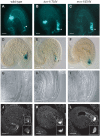TURAN and EVAN mediate pollen tube reception in Arabidopsis Synergids through protein glycosylation
- PMID: 25919390
- PMCID: PMC4412406
- DOI: 10.1371/journal.pbio.1002139
TURAN and EVAN mediate pollen tube reception in Arabidopsis Synergids through protein glycosylation
Abstract
Pollen tube (PT) reception in flowering plants describes the crosstalk between the male and female gametophytes upon PT arrival at the synergid cells of the ovule. It leads to PT growth arrest, rupture, and sperm cell release, and is thus essential to ensure double fertilization. Here, we describe TURAN (TUN) and EVAN (EVN), two novel members of the PT reception pathway that is mediated by the FERONIA (FER) receptor-like kinase (RLK). Like fer, mutations in these two genes lead to PT overgrowth inside the female gametophyte (FG) without PT rupture. Mapping by next-generation sequencing, cytological analysis of reporter genes, and biochemical assays of glycoproteins in RNAi knockdown mutants revealed both genes to be involved in protein N-glycosylation in the endoplasmic reticulum (ER). TUN encodes a uridine diphosphate (UDP)-glycosyltransferase superfamily protein and EVN a dolichol kinase. In addition to their common role during PT reception in the synergids, both genes have distinct functions in the pollen: whereas EVN is essential for pollen development, TUN is required for PT growth and integrity by affecting the stability of the pollen-specific FER homologs ANXUR1 (ANX1) and ANX2. ANX1- and ANX2-YFP reporters are not expressed in tun pollen grains, but ANX1-YFP is degraded via the ER-associated degradation (ERAD) pathway, likely underlying the anx1/2-like premature PT rupture phenotype of tun mutants. Thus, as in animal sperm-egg interactions, protein glycosylation is essential for the interaction between the female and male gametophytes during PT reception to ensure fertilization and successful reproduction.
Conflict of interest statement
The authors have declared that no competing interests exist.
Figures






References
-
- Palanivelu R, Brass L, Edlund AF, Preuss D (2003) Pollen tube growth and guidance is regulated by POP2, an Arabidopsis gene that controls GABA levels. Cell 114: 47–59. - PubMed
Publication types
MeSH terms
Substances
LinkOut - more resources
Full Text Sources
Other Literature Sources
Molecular Biology Databases
Research Materials
Miscellaneous

